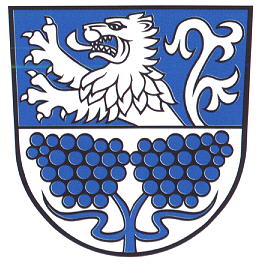Guthmannshausen: Difference between revisions
Jump to navigation
Jump to search
Knorrepoes (talk | contribs) m (Text replacement - "/Arms of " to "/Arms (crest) of ") |
Knorrepoes (talk | contribs) m (Text replacement - "{{media}}" to " {{de1}} {{media1}}") |
||
| Line 25: | Line 25: | ||
The upper part with the silver lion is derived from the medieval arms of the Lords von Guthmannshausen, who originated from the area and had their estate in the village. The grapes in the base are a symbol of St. Wigbert, the patron saint of the oldest church in the village. | The upper part with the silver lion is derived from the medieval arms of the Lords von Guthmannshausen, who originated from the area and had their estate in the village. The grapes in the base are a symbol of St. Wigbert, the patron saint of the oldest church in the village. | ||
{{ | |||
{{de1}} | |||
{{media1}} | |||
[[Civic Heraldry Literature - Germany|'''Literature''']]: Ulle, 1998 | [[Civic Heraldry Literature - Germany|'''Literature''']]: Ulle, 1998 | ||
Revision as of 12:36, 26 December 2022
This page is part of the German heraldry portal |
Heraldry of the World |
|
German heraldry:
|
Selected collector's items from Germany:
|
GUTHMANNSHAUSEN
State : Thüringen
District (Kreis) : Sömmerda
Incorporated into : 2019 Buttstädt
| German |
Geteilt von Blau über Silber; oben ein wachsender rechtsgewendeter silberner Löwe, unten zwei blaue Weintrauben mit einem gemeinsamen Stiel. |
| English | No blazon/translation known. Please click here to send your (heraldic !) blazon or translation |
Origin/meaning
The arms were granted on June 30, 1993.
The upper part with the silver lion is derived from the medieval arms of the Lords von Guthmannshausen, who originated from the area and had their estate in the village. The grapes in the base are a symbol of St. Wigbert, the patron saint of the oldest church in the village.
Literature: Ulle, 1998


